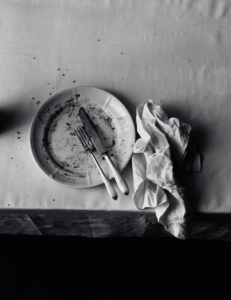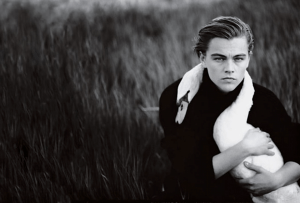Still Life Photography
Still life photography is the name given to photography that depicts found small collections of objects, usually placed together in the frame to create something perhaps portraying a greater message/idea. Important elements of this genre include lighting and framing. The aim of still life composition is to invent intriguing, visually questionable and odd compositions. Objects regularly used in compositions by famous photographers such as Lorenzo Vitturi include food and cutlery.
Other notable still life photographers such as Irving Penn and Edward Weston have notably used objects such as plants, skulls, scrambled eggs and even things as simple as a few blocks of wood. I am particularly inspired by Edward Weston’s work because he manipulates light in such an incredible way to not only highlight, but to complement the form and texture of the subject in his image. I also admire the fact almost all of his work is in black and white, giving him his own distinct mood and aesthetic, especially combined with his virtuosic use of light. I admire Irving Penn’s fascination with found metal objects. His images almost look almost industrial and, in terms of colourisation, he predominantly uses black and white, similar to Weston’s work. Penn’s visual ensembles prove that to him, the concept of still life to him was more than what other amateurs and professionals-alike perceived as the normal realms of still life.

Entropy
What is Entropy?
The topic I have chosen to focus on for my Independent project is ‘Entropy’. This can be defined as a lack of order or predictability, or, as a gradual decline into disorder. In physics, it refers to the measurement of how everything in the universe changes, moving from order to disorder. I will reflect this in my project where my subject, the angry busker, begins calm, then gets more and more angry, smashing up his guitar.
Capturing Emotion in Portraiture
Even though I am directing my subject to be reacting in a certain way, I still need to learn how to capture raw emotion through the lens. ‘Digital-photo-secrets.com’ has a wide range of interesting tips that I shall implement on my final project shoot. The author, David Peterson, firstly says that you should ditch the first photos of your shoot, as they are crucial for achieving that initial creative bond with your client, regardless of their relationship to you. He says that whilst photographing, the photographer should move about and engage in natural conversation with your client, so they feel relaxed and not like their acting as much. The opening few shots are also key in sorting out any issues with exposure, aperture and ISO.
Pearson next says that location matters; in such a way that you should complicate the location as you progress through the shoot, starting nice and simple with a relatively empty backdrop. Then, when the subject is warmed up and more relaxed, you can move into other locations where there’s more happening in the backdrop. Pearson says the purpose of this is to make the shoot more of an adventure and less about the camera.
Furthermore, he says that giving direction to establish a sense of control and hierarchy is a good way to get them to relax and smile. Giving directions allows the subject to realise the photographer is in total control and all they have to do is follow simple instructions. Moving the subject around to find optimal lighting positions is key early on in the process. The director must be very efficient in telling them how they should look, act and behave; detail by detail. He says ‘Once you find a position that works for your subject, it’s easier to direct people. From that, they’ll relax and show their true emotions’.
An interesting piece of advice David Pearson talks about on this post is you should always be on the ball, paying attention, ready for quality shots when the subject doesn’t think you’re shooting. Sometimes, these could be the best photos of the shoot as they are in a period of brief relaxation, which they think they’re having between shots. He says, ‘the in-between moments are when your subject comes alive again’, which suggests that in my shoot I should keep my head in the game, constantly looking out for golden shots when my subject thinks we are on a break.
Lastly, David Pearson infers that obtaining emotion from people is an art some people find easier than others. The photographer should visualise in the shoot element by element before proceeding. They must think where and how their subject will be positioned, as well and the equipment needed to complete the task. The more planned you are, the more relaxed the working environment will be, therefore resulting in a better shoot and better results.
A photographer who achieves this really well is Annie Leibovitz. She is a professional photographer know for her famous works for pop-culture, with shoots for companies such as Vogue and Vanity Fair amongst her many career achievements. Her photos, shown below, show such an in-depth level of expression, it feels like the reader is allowed past the exterior of the celebrity in question. It makes me feel like you can read their faces, which is predominantly a result of impeccably good practise from Leibovitz. Some photos, such as the photos of Adele and Jennifer Lawrence, leave scope for imagination. In my opinion, these images allow the viewer to explore their different expressions and use their own minds to try and grasp their emotion. The audience are sometimes left to decode surroundings as a result of enigmatic posing from the subject, to figure out the situation and emotion behind the person in frame.



Leave a comment